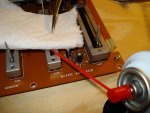Bro Man
I'm not sure if ZEE hangs on this site anymore. I've not seen nor heard from him in quite a while. I'll agree his pictorial of rubber refurbishment of a 244 is quite good. I'm not sure if he's ever touched on calibration issues, but I have. There is no easy "cheat" for calibration.
You need
a standard calibration tape from TEAC or other reputable source, not the so-called calibration tapes people make at home and sell on eBay. However, genuine TEAC cal tapes may be found used on eBay. Genuine calibration tapes are hard to find and expensive. I'm not sure they're being made anymore, but a while back TEAC sold the cal tape business to a Japanese technical firm. I'm sorry for being so vague, that's all I remember. Somewhere on my older computer I might have a link or
reference.
You will also need a DVM, audio oscillator test signal generator, and to do it right also an oscilloscope for head azimuth align.
In general: (following the Service Manual you bought from TEAC)...
~ Align the head azimuth using the calibration tape and an oscilloscope.
(NOTE: I've usually opted to gloss over and skip this step. It's very touchy to align, is factory set and loctite'd in place, and I've found having done it once or twice that it usually doesn't need messing with).
~ Calibrate the VU meters using a known -10dbV test signal (0VU= 0.316V)
~ Calibrate the playback amps using
the standard calibration tape
~ Calibrate the record amps using a known 0VU test signal. This is done by recording, rewinding, playing back and making adjustments until what you put into it is what it gives back to you.
** While you're in there, and if you have a frequency counter, you should calibrate the Speed, too! **
There are some caveats. Rec/PB amps are recommended to be calibrated by unhooking the dbx card and jumpering the empty connector for continuity. Then you'd have to calibrate the dbx encode/decode afterward. I will have to try that next time out, but I opted to skip that and calibrate with dbx in. I think as long as you're calibrating to standard levels and there were no problems with the dbx encode/decode previously, you should be ok. I had no noticeable problems, but for the record I'll do it by the book next time. Circuits do drift, and the dbx section may well have drifted and may need calibration too. As yet TBD/TBA.
Another caveat is Bias, which if you venture in this realm could prove very difficult and/or problematic. Being a 2-head design, there's a process of recording a test tone on tape, rewinding, playing back and adjusting for incongruencies between a 1K and 10K test tone. Due to the tedious and particular nature of this operation, plus the relatively small window of adjustment you're shooting for, I've deemed this to be too delicate and potientially problematic to mess with. The manual states that Bias should not be touched unless the record amp is replaced. I'm happy enough with that & have had no noticeable problems.
The only other anecdotal thing I have about bias is when I calibrated my Tascam 34. The 34 is a 3-head deck and is much easier to align than a 2-head deck. I decided to go all in on this at that time, but I found when I went thru the adjustment that it was already spot on before I started. It had not drifted the way so many other circuits drift and need calibration. I calibrated bias anyway by virtue of having messed with it already, but decided it didn't need it. I'd suspect the 244 bias would be stable much like the 34 was, being from the same time period and engineering batch.
There may be more highly trained and attuned techs on this board who might want to crucify me for this post, or for an alignment/calibration that skips or glosses over steps, but I've generally gotten excellent results doing things my own way and I do have a formal background as a tech. However, this is only my experience and anecdotal, and YMMV.







 , I had to pick pieces of belts from all over inside the unit. I wonder if sitting in the heat for long time may be the reason ????
, I had to pick pieces of belts from all over inside the unit. I wonder if sitting in the heat for long time may be the reason ????



 Many Thanks,
Many Thanks,
